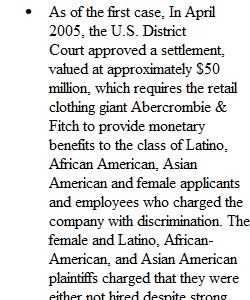


Q In this Discussion, please post brief analytical answers to the questions posed and respond to 3 classmates. In your answers, at a minimum show that you have read the case and understood it; for maximum credit, show that you have analyzed its business significance and/or done outside research or reading in the textbook to understand the legal issues in depth. Abercrombie Cases 1. First case -- 2005. Would A&F have lost this case even if they could prove that their top management was not racist and had no intention of discriminating against minorities? Why did A&F permit the practices that occurred in this case? Do they have any strong defense available? 2. Second case - Khan v A&F. Here an employee was grievously insulted by a manager based on a "protected class" characteristic, but she lost the case? Why did she lose? What advice does this suggest for employees and for companies? 3. Third case -- Headscarf case. Here A&F loses again, several years after the first case. Why is A&F still losing this kind of case? Why didn't they learn from the first case? Do they have any legitimate defense? Patrice Lataillade v Marc Jacobs 4. Is it possible for a straight man to sexually harass another man? Is there a valid sexual harassment or discrimination claim here? Why or why not? Kimba Lo v American Apparel 5. Is it any defense to a sexual harassment lawsuit to claim that the sexual relations were consensual? AA was sued several times for similar incidents, why didn't the behavior stop? Have you read anything in the news lately that sheds light on this case? What does it tell you about employment in creative industries? What should companies do?
View Related Questions